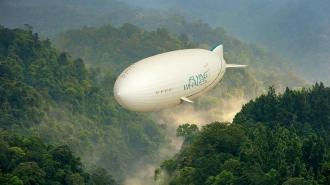The ambitious (and aptly named) French/Quebecois firm Flying Whales will work with Honeywell to power their hybrid-electric airships, Honeywell announced.
Flying Whale’s LCA60T airship will use Honeywell’s 1-megawatt generator to ply the skies after being vertically launched, using helium. It is Honeywell’s most powerful ever generator, Reuters reported.
“Our generator is four times as powerful as any other generator flying today, and at unmatched power density,” said Dave Marinick, president of engine & power systems for Honeywell Aerospace.
“Honeywell’s 1-megawatt generator is a perfect fit for a transformational aircraft like the LCA60T.”
The future, massive, hybrid-electric airships will be powered by Honeywell’s most powerful generator.
Sky behemoths: Airships have been seeing something of a mini-renaissance as of late, as the aviation industry searches for ways to minimize its carbon footprint.
Perhaps the biggest swing yet came from Spanish airline Air Nostrum last summer, which announced plans to purchase a small flotilla of 10 airships from the UK’s Hybrid Air Vehicles, with plans to fly them on short regional routes in Spain.
Flying Whales’ aims are focused on air cargo.
The LCA60T will be massive, at 656 feet long with a 164 foot diameter — considerably beefier than the famed Goodyear Blimp, which is a mere 246 feet long — and capable of carrying loads of up to 132,000 pounds, Flying Whale says. The airship’s rigid skeleton hides cells containing helium to lift it, and a 4-megawatt hybrid power chain will power it for flight.
Originally designed for lofting timber out of remote areas, the airship can be loaded up while hovering, providing logistical options that other aerial cargo options — basically, planes, helicopters, and drones — cannot.
With funding from, among others, the French and Quebec governments, Flying Whales plans to fly the LCA60T for the first time in 2025, and manufacture 150 aircraft within the next ten years.
With funding from, among others, the French and Quebec governments, Flying Whales plans to fly their airship for the first time in 2025, and manufacture 150 aircraft within the next ten years.
Whale power: Those future airships will draw their power from a combination of a jet fuel and sustainable aviation fuel (SAF) engine and electric engines, similar to hybrid vehicles on the road today. The Honeywell generators will provide the power for the electric engines. The LCA60T will incorporate four of the 1-megawatt generators each.
The 1-megawatt generator finished its first round of testing last May, Honeywell said. Because it generates considerable power for its weight and runs at roughly 97% efficiency, the manufacturer feels it may be an ideal power source for hybrid aviation.
We’d love to hear from you! If you have a comment about this article or if you have a tip for a future Freethink story, please email us at [email protected].






